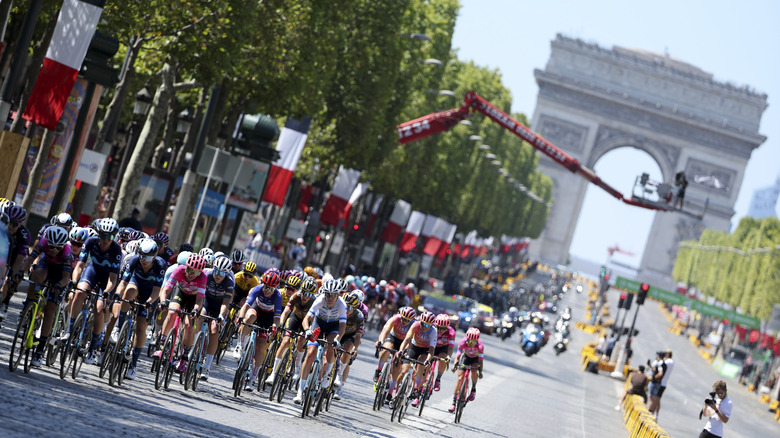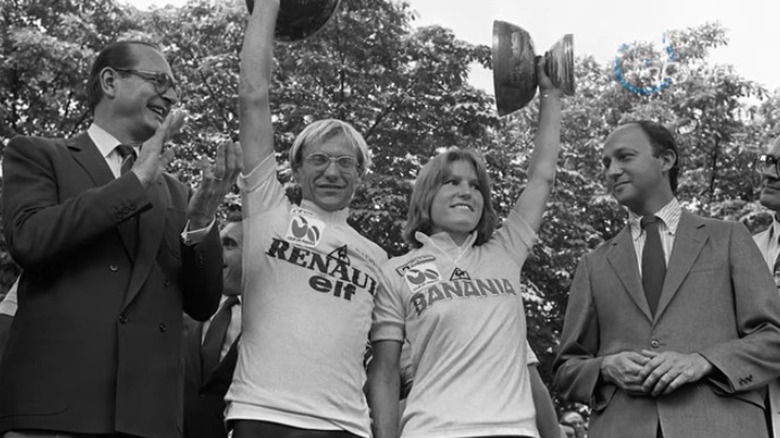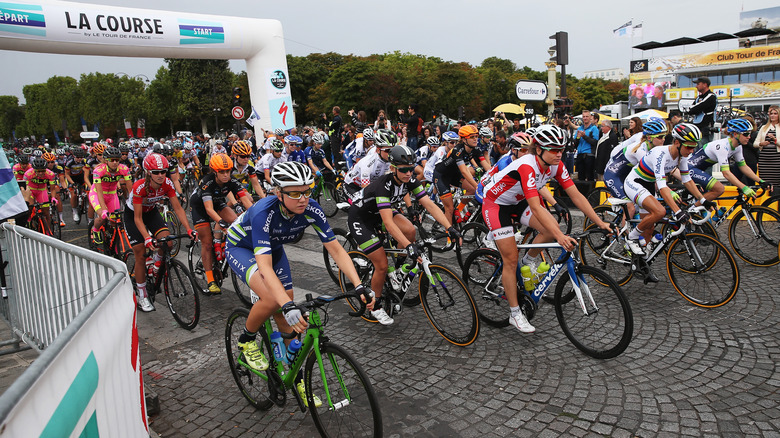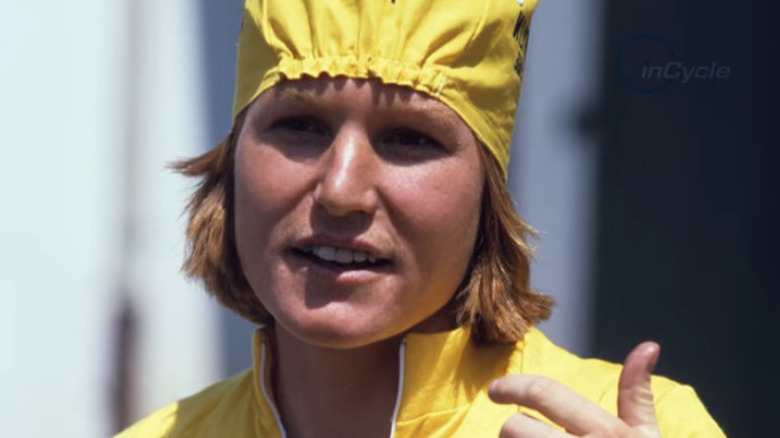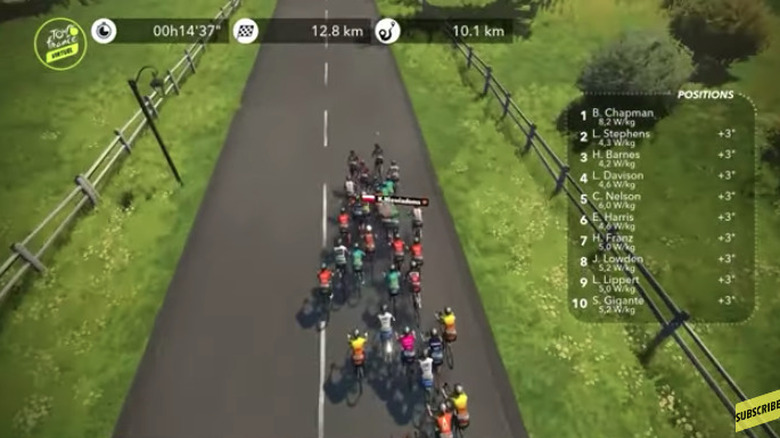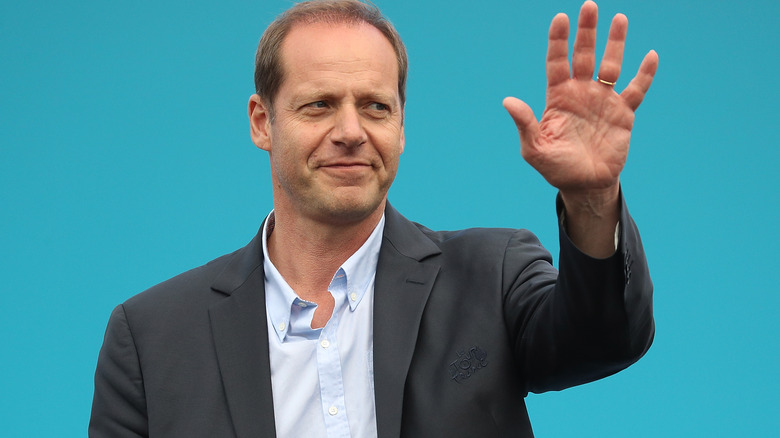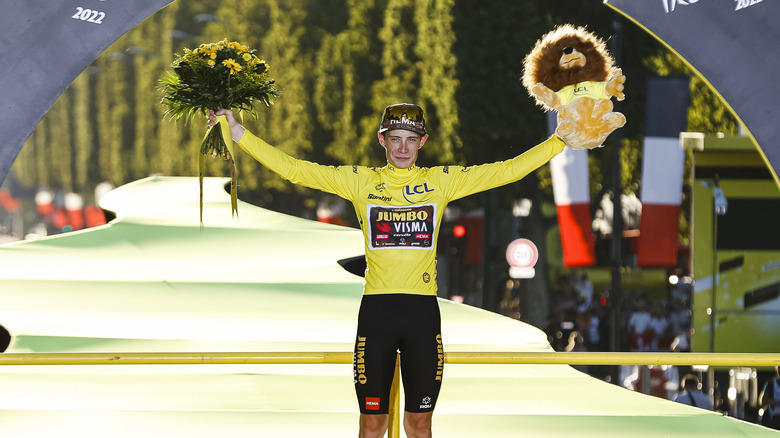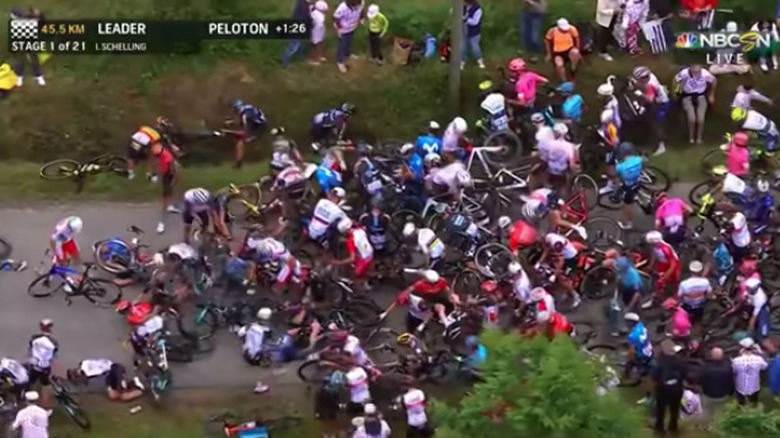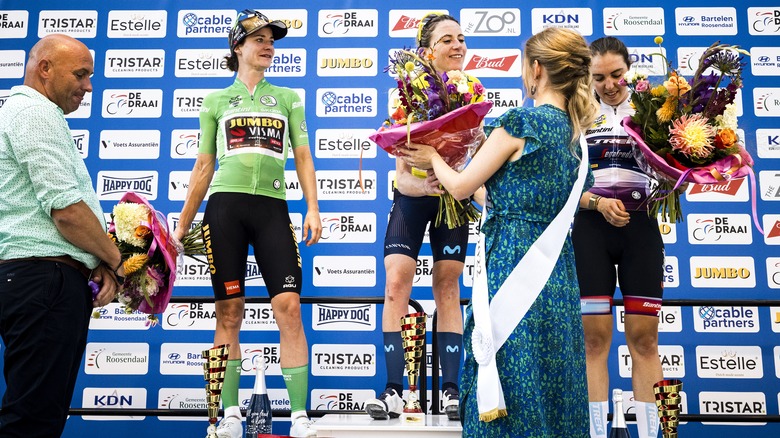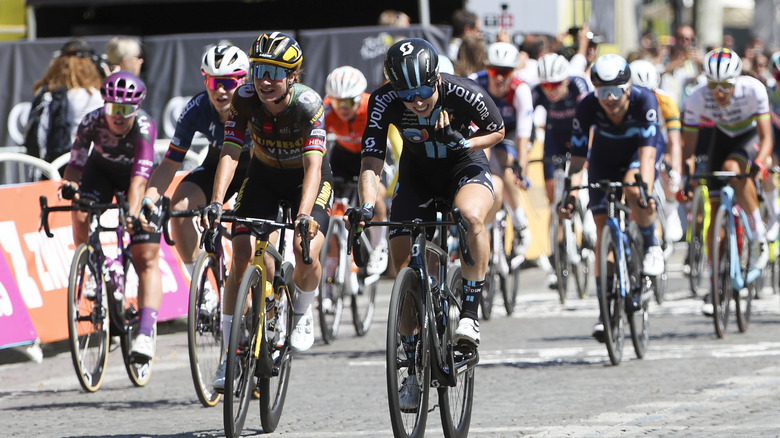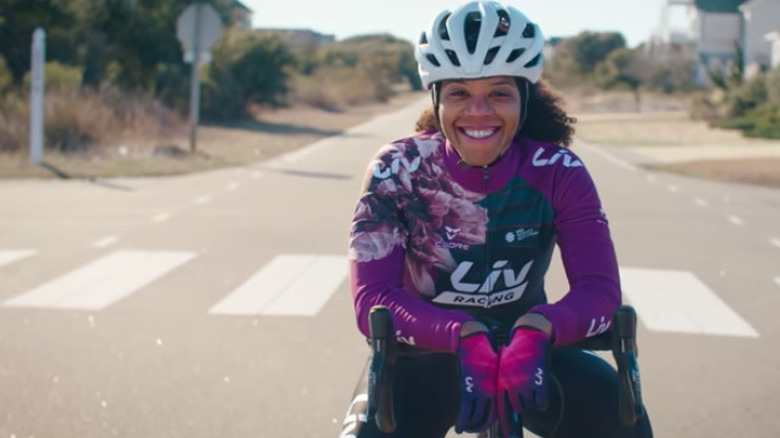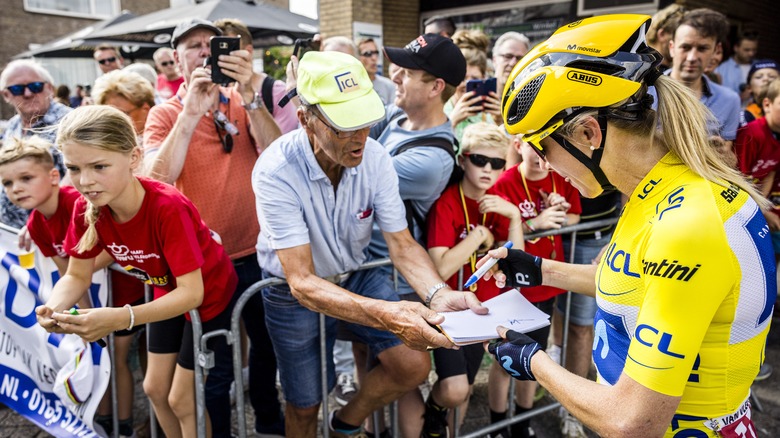The Untold Truth Of The Women's Tour De France
It's been a long time coming, but women finally have their own Tour de France — again. Thirty-three years have passed since the inaugural Tour de France Féminin in 1984, but the newly launched Tour de France Femmes avec Zwift looks promising. With a four-year sponsorship from fitness company Zwift and more broadcasting attention than ever before, the 2022 women's Tour is heralding a new era for women athletes. Nearly 20 million viewers in France tuned in to watch coverage of the entire race, while the finale alone attracted five million viewers, per Cycling News. The men's Tour de France is known for being the most-watched sporting event in the world, with a total viewership of 3.5 billion, per Peloton Magazine. Female cyclists can now take a piece of that pie.
The race featured 1,033.6 kilometers — or 642.2 miles — with increasingly challenging terrain and a final leg through the mountains. There were 24 teams competing with six riders each. The winner was Annemiek van Vleuten of Movistar, who over $250,000 in prize money, per Le Tour Femmes. Read on for untold truths about the inaugural women's Tour de France.
The first women's Tour de France was a one-off in 1955
The true first women's Tour de France occurred in 1955 when sports journalist Jean Leulliot launched the first world championship for women cyclists. He had experience directing other races, like the Paris-Nice race, which he ran for 25 years, per VeloNews. Leulliot wanted the race to have seven stages that were 80-100 kilometers each — or 49.7 to 62.1 miles — but only five stages were approved. There were 41 participants, and the winner was a cyclist from the Isle of Man, Millie Robinson. She won the race by 35 seconds over British cyclist June Thackeray, per VeloNews.
Many of the contestants were British since they had experience with time trials, according to Rene Herse Cycles. Robinson herself had just won all three stages of the largest cycling race for women at the time — the Circuit Lyonnais-Auvergne. The first few stages of the 1955 women's Tour de France were won by Frenchwoman Lyli Herse until the fourth stage, which was when the race was taken over by Robinson. She dominated the time trial during the fifth stage, cycling at an average speed of 23.6 miles per hour.
After the race, Leulliot focused his attention onto other projects, and the idea of a Tour de France Féminin was left alone until 1984.
The race has struggled to find support and financial backing
The 1984 inaugural Tour de France Féminin was meant to be the start of a preeminent world championship for women's cycling. According to The Washington Post, it had 18 stages and covered 600 miles, the longest Tour race for women to date, per Rene Herse Cycles. And most importantly, it was being launched by the organization behind the men's Tour de France, Société du Tour de France. But public interest in women's sports hampered the race's success. It lasted only six years before it was shut down due to the lack of financial support. In 1989, the director of the Tour de France, Jean-Marie Leblanc, cited limited media coverage and sponsorship for the race's collapse, per VeloNews.
The race had been on a decline since it started. The number of stages fell from 18 to 11 by its final year, and the women also had to work in order to support themselves. Today, 14 of the 24 teams competing are required to give their members a minimum salary, per The Washington Post. Women cyclists in 1984 also had to compete for attention alongside men since their races were held at the same time, per the New York Times. Additionally, the men had nicer accommodations and meals. To top it all off, the women's prize money was a mere $1,000 while the male winner earned more than $100,000.
The women's Tour de France was replaced by smaller races
To fill the void left by the failed Tour de France Féminin in the '80s, other races for women popped up in its place. As VeloNews details, from 1990 to 1993, the Tour of the EEC Women had nine to 12 stages. Its first champion was Frenchwoman Catherine Marsal. It received no support or mention from the Société du Tour de France, which later became part of the Amaury Sport Organization (ASO) in 1992.
In 1992, French journalist Pierre Boué took it upon himself to bring a new race, the Tour Cycliste Féminin, but it was riddled with problems. Boué struggled to find financial support, as Marion Clignet, who took second place in 1993, remembers the women's race being very unassuming with little fanfare at the time (via Cycling News). So it's no wonder sponsorships were hard to find. Competitors also had to deal with long neutral starts and long transfers while the number of stages changed by year since towns willing to host were hard to find. Not the mention the fact that there was little to no prize money year to year for the winners.
But the race wasn't without merit, and it allowed women to feel as if they had their own Tour de France. Boué was set on giving a race to women that was competitively long and that proved to the world that they could handle it, per Cycling News. At its inception, the race had nine stages, which rose to 14 in later years. In 1993, the race covered 1,000 kilometers — or 621.3 miles — and included a dramatic climb up l'Alpe d'Huez, which was unprecedented for women's races.
Only one American has won it
When the Tour de France Féminin debuted in 1984, America made its mark through the race's first champion, Marianne Martin. Both the men's and women's races were held at the same time, so Martin, along with other female cyclists, sometimes benefitted from the attention that the male cyclists usually received. The women raced ahead of the men's peloton as they traversed the same tortuous legs up the Alps and Pyrenees, as per h NPR. They were greeted by the same fans as they toured the same last 37.2 miles.
Martin was even able to share the podium with the men's champion, Laurent FIgnon. Despite all this, she recalled the stark inequality between the two groups in an interview with NPR. For one, her prize was only around $1,000, while Fignon received more than $100,000. People also didn't expect women to finish the race at all. She said there was a significant difference in their experiences.
But Martin's win was an impressive event to remember, especially since she hadn't prepared. When she first tried out, she wasn't in good physical shape, so she was left off the team. But after doing well in a United States national race, the national team coach relented and gave her a spot. She also had been racing in the Olympic trials for a chance to compete for the national team, but she preferred the Tour de France opportunity. In the end, Martin won by a margin of three minutes.
The rebirth of the women's Tour de France began with a virtual race
When the world was on lockdown in 2020, virtual fitness company Zwift debuted a virtual Tour de France. The in-person race was postponed for August, but it left a void in the month of July, when racing is usually held. The virtual Tour de France gave both men and women a chance to compete with identical stages and distances, along with the same broadcast coverage, per Cycling Weekly.
While Zwift had a history of promoting women's cycling and making it its mission to provide equal opportunity, the virtual event proved that women's racing was ready for an upgrade. According to NPR, the virtual event was broadcast in 130 countries, and the company found that viewership was evenly split between the men's and women's races. The virtual race's success helped change minds at the ASO, the organization responsible for the Tour de France, and with Zwift's four-year sponsorship, a Tour de France Femmes became a reality.
Women cyclists were initially skeptical about the virtual race. American cyclist Lily Williams said she didn't want to ride inside because it would involve staring at a wall, which could make the experience harder. However, the importance of its total success can't be understated since it nudged the ASO to finally act. Linda Jackson, the owner of EF EDucation-TIBCO-SVB women's cycling team, told the New York Times that ASO wasn't motivated by women's equality but rather the tangible engagement Zwift propelled.
The ASO chief didn't have faith in the Tour's success
Tour de France director Christian Prudhomme might have sounded like a hero when he confirmed that a Tour de France Femmes would debut in 2022. But he quickly soured his own moment of glory during a 2021 interview when he told The Guardian that women's races always lose the Amaury Sport Organization (ASO) money. After confirming the date of the Tour de France Femmes, Prudhomme stressed that this new race must not repeat the same mistakes as previous women's championships — namely, it must make money. If not, Prudhomme warned, it would go the way of the 1984 Tour de France Féminin. He also emphasized the fact that despite it being a bad investment, the ASO continued to organize women's one-day races.
The reaction was swift. Cyclist Kathryn Bertine called Prudhomme's comments sexist and ignorant, per Cycling News. She argued that women's events do, in fact, make money but lack the promotion and support from the ASO. The organization has the power to make money from any event if they want to. However, she agreed with some of Prudhomme's solutions to strengthen the race's longevity and relevance, such as scheduling the race after the men's. That way, the men's race wouldn't overshadow the women's. Bertine said that the ASO had a responsibility to then promote the Tour de France Femmes extensively on its own.
The prize money is €1.9 million less than the men's Tour de France
Nothing is more emblematic of the disparity between the Tour de France's men's and women's races than their prize money. The men's Tour de France champion receives €2.2 million while the female champion receives a total of €250,000, according to CNN. To make matters worse, women have struggled to make a living while cycling. Many have had to work second jobs or otherwise reimburse their cycling team for expenses they incurred, such as bike maintenance and repair and medical costs.
In 2021, the Union Cycliste Internationale (UCI) mandated that teams in the top tier of cycling, Women's WorldTour teams (WWT), must raise competitor salary to $27,961, more than a $10,000 increase from 2020. By 2023, team members will see about a $5,000 increase in their salary. However, tiers below WWT teams remain unprotected. In a 2022 survey, 60% of non-WWT professional cyclists said they didn't get paid at all.
Financial burdens have hampered the ability for women cyclists to hone their craft. Marianne Martin, the Tour de France Féminin's 1984 world champion, said she had to pay her own way to France. In order to get onto the team, she had to participate in numerous races in America and had to use her credit card to get by. By the time she retired, she was in debt.
The 2022 inaugural race had a huge pile-up
During stage five of the Tour de France Femmes, catastrophe struck. Contact between two cyclists caused a huge pile up with cyclists crashing into each other. People screamed as medics rushed on the scene, and athletes struggled to disentangle themselves and remove their feet from the spokes of competitors' wheels, according to UPI. The incident occurred with 31 miles left in the stage. Half of the women's peloton fell off their bikes, with several minutes passing before the athletes could recover and return to form. Many were left with minor injuries, but Movistar's Emma Norsgaard had to leave in an ambulance, effectively ending her race. In a post on Instagram, the team told its followers that she had hit her head, neck, and left shoulder. Movistar later reported on Twitter that Norsgaard remained under medical observation for 24 hours.
SD Worx's Chantal van den Broek-Blaak was another cyclist who was injured and had her right arm bandaged while riding in the team car. Former British cyclist Dani Christmas attributed the large crash to a false sense of security when riding among the pack, leading cyclists to lose attention. She also noted taht speed they were going only made things worse, per Eurosport.
The 2022 winner suffered a stomach bug and five bike changes
Tour de France Femmes champion Annemiek van Vleuten had a rough journey to her win. Only two hours after stage one ended, van Vleuten was hit with a stomach bug, per VeloNews. She couldn't eat or drink but hinted that the symptoms were fleeting whenever she felt them. The issue lasted for more than a day, and the recovery period was difficult for her, as well. She continued to suffer through stage two, which she lost, but she recovered during stage three — where came in second place.
Her struggles didn't end there, however. Stage four's gravel tracks were, according to her, "bad luck." During the eighth and final stage of the race, van Vleuten had to change her bike five times, according to Cycling Weekly. The first time was done on purpose. She began the race on an all-yellow bike that was gifted to her moments before. Strange as it might sound, the paint weighed too heavily on the bike. But van Vleuten anticipated this, and she switched to her comfort bike — a black bike with yellow accents. That wasn't the end of it. She ran into mechanical issues with the bike and had to switch again, this time with a teammate. Once her preferred bike was repaired, van Vleuten hopped off, again, and rode to victory.
The race received more support than they ever had
Public engagement with professional women's cycling has come a long way. For one, the devoted backing from Zwift is unprecedented. And then there's all of the publicity and attention. Prior to the race, one of the competing teams, Le Col Wahoo, and its sponsors teamed up with the Global Cycling Network to give away 10,000 subscriptions so that fans could watch the race for free, per CNN. As for everyone else, multiple stations made live coverage available. NBC Sports received the rights to broadcast it in the U.S. for both 2022 and 2023. Fans in Europe could have tuned into Discovery Sports and Eurovision Sports. It was also available on SBS OnDemand in Australia and on ESPN in Latin America and the Caribbean, per VeloNews.
There was two-and-a-half hours of live television coverage of the women's tour each day of the race, which athletes hoped was enough to change interest in the sport and believed the future hinged on the 2022 race's popularity, per the New York Times. Zwift, the fitness company sponsoring the race, agreed to back the Tour de France Femmes if there was a good broadcasting plan behind it. They believed it was the key to its success, per NPR.
The race needs more diversity
Ayesha McGowan is the first African-American woman on a professional cycling team, and although she likes being the first, she doesn't want to be the only one. She created Thee Abundance Project and its 2022 Micro Grant Program to provide women from ethnic minorities funding for expenses related to cycling: housing, transportation, and other fees, reports CNN. McGowan believes there are common misconceptions when it comes to women from underrepresented communities and their numbers in cycling. People assume that their low numbers are indicative of a lack of interest, but McGowan believes that if opportunities are created, these women will show up, notes NBC Sports. Opportunity generates participation, since it opens a door that women from minority communities wouldn't have otherwise.
McGowan herself only began competitive cycling when she was 26. Acknowledging the progress made for all women in cycling with the inaugural Tour de France Femmes and the new minimum salary requirements, she wishes there was more diversity in the race and hopes to see more progress on that front. McGowan couldn't participate with her team, Liv Racing Xstra, in the Tour because she was recovering from myomectomy surgery. But she hopes to race in it next year.
Cyclists want changes to the women's Tour de France
There's room for the Tour de France Femmes to evolve, and cyclists have called for certain changes. For one, there weren't any time trials included in the race. In the men's Tour de France, cyclists have to race against the clock across 8.1 miles during the first stage. Time trials can be done individually or by team, and there are men's competitions that are solely based on time trials, per Cycling Weekly. Although it's an expected element in stage races, women's championships infamously lack them. There were only two WorldTour races that had time trials, one at the Giro Donne and another at the Simac Tour. Women cyclists felt the Tour de France was incomplete without it since it contained several of the other disciplines common in stage races, per Cycling News.
Cyclist Kathryn Bertine has focused her attention on other changes, including increasing the Tour's length to 21 days to keep it on par with the men's, according to The Guardian. She's concerned that shorter distances convey to the public that women cannot handle the same distances as men. She also finds issue with the prize money, which is only a tenth of what the men's champion earns. Bertine was part of a 2013 lobbying group that pressured the ASO into forming a women's Tour de France, and the resulting product was La Course, a one-day race that ran from 2014 to 2021 and ushered in the current Tour de France Femmes.
